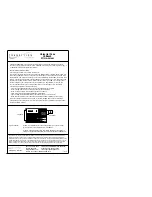
4 BASIC OPERATIONS
4-8
CONFIGURING THE OPERATING BAND
You can select your desired operating band.
The band can be configured for the main band and the
sub band, respectively. With the numeric keypad, you can
instantly select an amateur band ranging from the 1.8
MHz band to the 50 MHz band and the general band.
The transceiver’s band memory function allows you to
store up to five configurations for each band, with the last
used frequency and operating mode.
This can be convenient if you are in a contest, in order to
return the frequency and operating mode to their original
states each time you change bands.
[1.8]〜[50], [GEN1], [GEN2], [ENT], [CLR]
Band Select Keys
[MULTI / CH]
1 Press the band keys
[1.8]
to [50], [GEN1], and [GEN2]
to store the frequency and operating mode.
When you press a key, the transceiver stores the VFO
frequency and the status of the operating band at that
moment, and then enables the operation of the next memory
band. Each time you press a key, the band memory cycles
from Band Memory 1 to Band Memory 5. The band memory
number appears below the frequency display, on the main
screen.
Note:
◆
Frequencies outside the band memory frequency range cannot be
stored.
ADJUSTING THE RF GAIN
You can adjust the received sensitivity gain. Two
independent RF controls are available for the main band
and for the sub band, respectively. In normal operation,
you can fully rotate the RF control counterclockwise. If an
external noise or interference by another station is present,
rotate the control counterclockwise slightly to decrease the
gain and listen to the received audio.
[RF(M)] [RF(S)]
1 Rotate the RF (M) or RF (S) control to adjust the RF
gain.
Rotate the RF control counterclockwise and adjust the signal
to not be below the peak value range, while viewing the peak
value on the S-meter. Signals weaker than this level are
attenuated.
Note:
◆
Depending on the type of antenna and the band conditions, better
reception may sometimes be obtained if the control is rotated
slightly counterclockwise rather than always positioned fully
clockwise.
ADJUSTING THE SQUELCH LEVEL
The threshold level for Squelch, a function to eliminate the
audible noise on the frequency where no signal is present,
can be adjusted. Two independent SQL controls are
available for the main band and the sub band, respectively.
[SQL](S)
[SQL](M)
1 Rotate the SQL (M) or SQL (S) control to adjust the
squelch level.
•
Rotating the SQL control clockwise raises tightens the
squelch level and counterclockwise opens it.
•
You can rotate the SQL control until the squelch noise
disappears.
Note:
◆
The position of the SQL control, where noise disappears, varies
depending on the signal, temperature, and operating environment.
◆
The position of the SQL control in FM mode, where noise
disappears, differs from other modes.
Summary of Contents for TS-990S
Page 1: ... B62 2389 10 09 08 07 06 05 04 03 02 01 HF 50 MHz TRANSCEIVER TS 990S INSTRUCTION MANUAL 1 01 ...
Page 2: ......
Page 42: ......
Page 54: ......
Page 78: ......
Page 154: ......
Page 164: ......
Page 168: ......
Page 192: ......
Page 224: ......
Page 232: ......
Page 270: ......
Page 284: ......
Page 290: ......















































